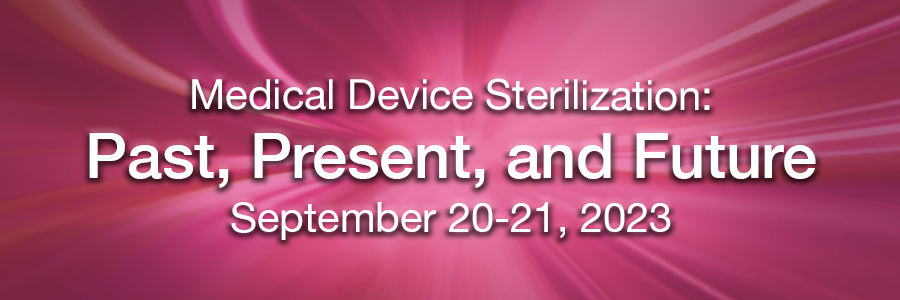Medical Device Sterilization Workshop 2023: Past, Present, and Future
Tollestrup Auditorium
 Overview: On September 20 and 21, 2023 the Organizing Committee of the Medical Device Sterilization Workshop will host a hybrid workshop for stakeholders exploring sterilization alternatives using accelerator-based radiation.
Overview: On September 20 and 21, 2023 the Organizing Committee of the Medical Device Sterilization Workshop will host a hybrid workshop for stakeholders exploring sterilization alternatives using accelerator-based radiation.
The in-person workshop will take place at Tollestrop Auditorium on the Fermilab Campus in Batavia, Illinois.
Hybrid sessions will take place:
- 8:00 am CDT to 12:30 pm - Wednesday, September 20
- 8:00 am CDT to 12:15 pm - Thursday, September 21
Afternoon discussion sessions will be in-person only.
On Wednesday, September 20, there will be a no-host social event at Two-Brothers Roundhouse in Aurora (20 minutes away).
REGISTRATION DEADLINE: September 8, 2023 in-person, September 13, 2023 virtual
Virtual registration is free. Just ignore the registration and lunch fees.
Selecting lunch is highly recommended for in-person. There are no convenient off-site options. (registration and lunch are separate for administrative reasons.)
Important Registration Information:
- Point of Contact – Thomas Kroc
- Affiliation – Medical Device Sterilization Workshop 2023
- Are you affiliated with an institution - say "Yes"
- Home Institution Search -
- other - then add your place of employment
- Anyone traveling from outside of the US should ensure their passport or visa is marked as business travel.
Morning sessions will be streamed. This year, the FDA is ramping up its participation, going beyond last year’s mock-presub to discuss next steps. An international panel of regulators will look at differences in the regulatory processes in various countries and potential ways to harmonize them.
Invited Speakers
Keynote presentation – Nicholas Butler (NNSA)
- Ryan Ortega, FDA
- Emily Craven, Boston Scientific
- Samuel Dorey, Sartorious
- Vu Lekate, Abbott
- Kim Patton, MedAccred
- Martell Winters, Nelson Labs
- John Williams, Medtronic
- Mark Pasmore, Baxter
- Mara Senescu, Baxter
Organizing Committee
- Debbie Cotton (Retired)
- Thomas Kroc (Fermilab)
- Vu Le (Abbott)
- Mark Pasmore (Baxter)
- Mara Senescu (Baxter)
- John Williams (Medtronic)
Who should attend: Recent events in the medical device sterilization community reinforce that patient safety, in particular sterility assurance, is not specific to any particular company, vendor, or institution. This forum seeks to bring together voices from across these various organizations to define and build the future of this industry, for the benefit of the patients we serve. Participants from technical, business, and regulatory functions from the following organization types will benefit from workshop participation:
- Medical device manufacturers
- Accelerator manufacturers
- Contract sterilization vendors
- Medical device regulators
- Medical device regulatory
- Medical device and sterilization laboratories
Attendees should expect to:
- Examine the current science of radiation sterilization techniques (X-ray, gamma, and E-beam)
- Maintain connection with developments in the use of alternative technologies for medical device sterilization
- Influence discussion on the direction of medical device sterilization and potential collaboration opportunities and mechanisms to help realize that future
- Interact with staff of the FDA to better understand how to work with the FDA for approvals for new and existing products
Aaron Starkey
Abbas Nasreddine
Abigail Honetschlager
Adriana Allen
Aftin Ross
Aja Thomas
Alex Emiru
Alexander Paczynski
Amber Foster
Anand Tahiliani
Andre Paes de Almeida
Andrew Klein
Andrew Patton
Andrew Porteous
Arnaud Henry
Ashley Miller
Beth Marquez
BETTY HOWARD
Blaise Alexander
Brandon Shurdhi
Bret Ludwig
Brian McEvoy
Briana Gadola
Byron Lambert
Chris McMahon
Christian Cortez
Christiane Beerlage
Christophe Deneux
Christopher Boblett
Christopher Dugard
Christopher Merton
Christopher Merton
chuntao cao
Clarence Murray III
Damien PRIEELS
Dan O'Neal
Daniel Badali
Daniel Wojtczak
Dario Castillo
Darren Young
Dave Adams
Davi Waltz
David Hubbard
David Macrillo
Debora Thomas
Deborah Havlik
Deborah Havlik
Debra Cotton
Denise Cleghorn
Diane Faivre-Swiat
Douglas Bondar
Elizabeth Claverie
Ema Rajic
Emily Craven
Emma Muldoon
Eric Beers
Eric Meissner
Eric Olson
Evan Thompson
Fabiano Andreazza
Fabio Forino
Fernando Luna
FLORENT KUNTZ
frederic Dessy
Gregory Land
Gregory OBrien
Günther Burgstaller
Henk Blom
Ilia Getlser
Isabelle Arts
Isabelle Szot
Jackie Somadelis
Jade Schiesser
Jaim Nulman
Jake Gibbons
James Hathcock
Jami McLaren
Jamie Holdren
Javier Sanchez
Jeff Marincic
Jennifer Freitag
Jennifer Fried
Jennifer Zimmerman
Jeremy Behnke
Jim Maher
Jodi Lieberman
Joe Murga
Joern Meissner
John Schlecht
John Williams
Jon Jansson
Jordan Becker
Jose Gonzalez
Joseph Connaghan
Joseph Koenigsman
Karshun Kwok
Kathryn Lyons
Kathy Lane
Katie Schindler
Khalid FATOUAKI
Kim Patton
Krista Schulte
Kyle Gilles
Kyrstan Polaski-Hancock
Laura Wahlen
Lauren Specchio
Leah MacKrell
Leesa McBurnie
Leigh Taylor
Leo Fifield
Linh Lollis
Lisa Simone
Lisa-Gaye Pryce
Liv Arnold
Lorenzo Pedrazzini
Luca Rosenthaler
Lucia Polakova
MACARIO MORENO MATIAS
Magdalena Pierzchala
Mandeep Pathania
Mara Senescu
Marco Jara
Marcos Ruelas
MARIA GARMENDIA-HARO
Mariel González
Mark Earl
Mark Pasmore
Mark Simpson
Martell Winters
María Ciávaro
Mauricio Suarez
Max Baumgartner
Max Blomberg
Maxwell Nagarajan
Md Kamrul Hasan
Meghan Gelerman
Meredith Bondurant
Michael Flanagan
Michael Rust
Michael Sadowski
Michelle (Shelly) Luebke
MIGUEL Morales
Miguel Padilla
Mike Graybill
Molly Swanson
Monica Lemmon
Morgan Beaver
Nazal Naeem Mohammed
Nicholas Brydon
Nicholas Butler
Nick Wiseman
Nicole McLees
Nina Li
Nissa Rieck
Norman Aiello
Omar Peralta
Pam Cheok
Patrick Anibaldi
Patrick Weixel
Paul Boentges
Paul Sordellini
Pauline Poncet
Peter Noverini
Peter Schaefer
Philippe Dethier
Prasathbabu Mohan
Qiuge Zhang
Rachel Montoya
REMYA REGHUNATH S
Riccardo Renda
Robin Flaata
Roman Kostin
Ryan Ortega
Samuel Dorey
Scott Steffen
Sebestyen Nagy
Shari Formica
Sharon Lunney
Shaun Devitt
shaun McGinley
Simon Forknall
Simon Gonzales
Sopheak Srun
Sophie Rouif
Spencer Mickum
Sreekanth Gutala
Stacey Guilford
Stephen Anisko
Susan Mickens
Thomas Danner
Thomas Kroc
Tim Carlson
Timo Neumann
Tobias Funk
Todd Powell
tony piotrkowski
Travis Anderton
Tushant Ghode
Valeriia Starovoitova
Vanessa Vargas
Vartika Agarwal
Victor Lopez
Vincent Bartoletti
Vu Lekate
Wendy Wangsgard
William Schneider
Yasmin Abu Hweij
Ying Zhang
Yves Cherisien
Zabrina Tumaitis-Namba
Zachary Dukerich